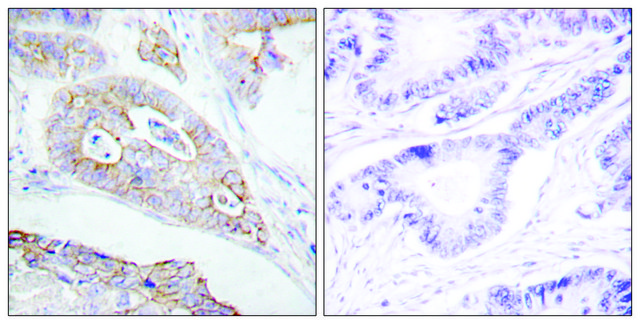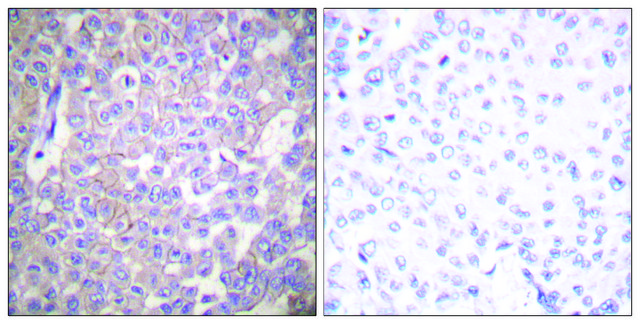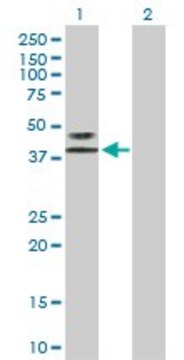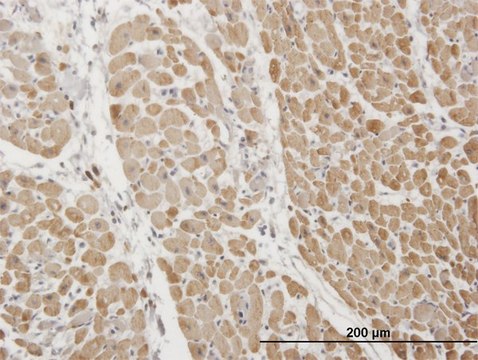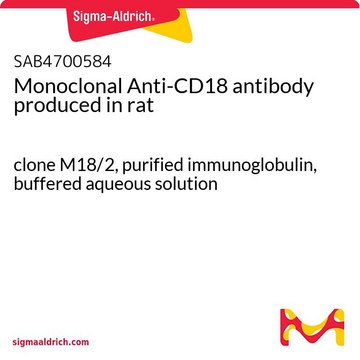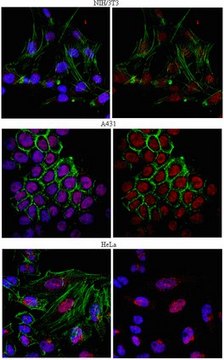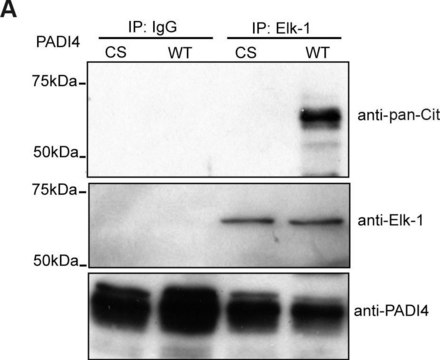推荐产品
生物来源
rabbit
质量水平
偶联物
unconjugated
抗体形式
affinity isolated antibody
抗体产品类型
primary antibodies
克隆
polyclonal
产品线
Prestige Antibodies® Powered by Atlas Antibodies
表单
buffered aqueous glycerol solution
种属反应性
human
增强验证
orthogonal RNAseq
Learn more about Antibody Enhanced Validation
技术
immunohistochemistry: 1:200- 1:500
免疫原序列
LVTGDNGDFTLRLEDVSQAQAGTYTCHIHLQEQQLNATVTLAIITVTPKSFGSPGSLGKLLCEVTPVSGQERFVWSSLDTPSQRSFSGPWLEAQEAQLLSQPWQCQLYQGERLLGAAVYFTELSSPGAQ
UniProt登记号
运输
wet ice
储存温度
−20°C
靶向翻译后修饰
unmodified
基因信息
human ... LAG3(3902)
一般描述
The protein lymphocyte-activation gene 3 encoded by the gene LAG-3 is expressed by various lymphoid cell types and plasmacytoid dendritic cells.
免疫原
Lymphocyte activation gene 3 protein precursor recombinant protein epitope signature tag (PrEST)
应用
All Prestige Antibodies Powered by Atlas Antibodies are developed and validated by the Human Protein Atlas (HPA) project and as a result, are supported by the most extensive characterization in the industry.
The Human Protein Atlas project can be subdivided into three efforts: Human Tissue Atlas, Cancer Atlas, and Human Cell Atlas. The antibodies that have been generated in support of the Tissue and Cancer Atlas projects have been tested by immunohistochemistry against hundreds of normal and disease tissues and through the recent efforts of the Human Cell Atlas project, many have been characterized by immunofluorescence to map the human proteome not only at the tissue level but now at the subcellular level. These images and the collection of this vast data set can be viewed on the Human Protein Atlas (HPA) site by clicking on the Image Gallery link. We also provide Prestige Antibodies® protocols and other useful information.
The Human Protein Atlas project can be subdivided into three efforts: Human Tissue Atlas, Cancer Atlas, and Human Cell Atlas. The antibodies that have been generated in support of the Tissue and Cancer Atlas projects have been tested by immunohistochemistry against hundreds of normal and disease tissues and through the recent efforts of the Human Cell Atlas project, many have been characterized by immunofluorescence to map the human proteome not only at the tissue level but now at the subcellular level. These images and the collection of this vast data set can be viewed on the Human Protein Atlas (HPA) site by clicking on the Image Gallery link. We also provide Prestige Antibodies® protocols and other useful information.
生化/生理作用
The gene LAG3 (lymphocyte-activation gene 3) encodes a member of the Ig superfamily. The encoded protein is a CD4-related molecule that interacts with and binds to MHC class II. It functions in the regulation of plasmacytoid dendritic cell homeostasis. It is expressed by activated natural CD4+CD25+ Tregs (regulatory T cells) and enhances the suppressor activity of CD4+ T cells towards effector T cells. It is involved in the regulation of Treg homeostasis and function, apart from mediating induced Treg development. This immune inhibitory molecule also functions in mitigating dendritic cell differentiation and function. It functions in synergy with programmed cell death 1 (PD-1) to facilitate tumoral immune escape.
特点和优势
Prestige Antibodies® are highly characterized and extensively validated antibodies with the added benefit of all available characterization data for each target being accessible via the Human Protein Atlas portal linked just below the product name at the top of this page. The uniqueness and low cross-reactivity of the Prestige Antibodies® to other proteins are due to a thorough selection of antigen regions, affinity purification, and stringent selection. Prestige antigen controls are available for every corresponding Prestige Antibody and can be found in the linkage section.
Every Prestige Antibody is tested in the following ways:
Every Prestige Antibody is tested in the following ways:
- IHC tissue array of 44 normal human tissues and 20 of the most common cancer type tissues.
- Protein array of 364 human recombinant protein fragments.
联系
Corresponding Antigen APREST71687
外形
Solution in phosphate-buffered saline, pH 7.2, containing 40% glycerol and 0.02% sodium azide
法律信息
Prestige Antibodies is a registered trademark of Merck KGaA, Darmstadt, Germany
免责声明
Unless otherwise stated in our catalog or other company documentation accompanying the product(s), our products are intended for research use only and are not to be used for any other purpose, which includes but is not limited to, unauthorized commercial uses, in vitro diagnostic uses, ex vivo or in vivo therapeutic uses or any type of consumption or application to humans or animals.
未找到合适的产品?
试试我们的产品选型工具.
储存分类代码
10 - Combustible liquids
WGK
WGK 1
闪点(°F)
Not applicable
闪点(°C)
Not applicable
个人防护装备
Eyeshields, Gloves, multi-purpose combination respirator cartridge (US)
法规信息
常规特殊物品
Zi-An Xia et al.
BMC medicine, 21(1), 268-268 (2023-07-25)
Tumour-infiltrating lymphocytes (TILs), including T and B cells, have been demonstrated to be associated with tumour progression. However, the different subpopulations of TILs and their roles in breast cancer remain poorly understood. Large-scale analysis using multiomics data could uncover potential
Sara Sf Al-Badran et al.
The journal of pathology. Clinical research, 7(2), 121-134 (2020-12-19)
The tumour microenvironment is an important factor for colorectal cancer prognosis, affecting the patient's immune response. Immune checkpoints, which regulate the immune functions of lymphocytes, may provide prognostic power. This study aimed to investigate the prognostic value of the immune
Creg J Workman et al.
Journal of immunology (Baltimore, Md. : 1950), 182(4), 1885-1891 (2009-02-10)
Lymphocyte activation gene 3 (LAG-3) is a CD4-related, activation-induced cell surface molecule expressed by various lymphoid cell types and binds to MHC class II with high affinity. We have previously shown that LAG-3 negatively regulates the expansion of activated T
Seng-Ryong Woo et al.
Cancer research, 72(4), 917-927 (2011-12-22)
Inhibitory receptors on immune cells are pivotal regulators of immune escape in cancer. Among these inhibitory receptors, CTLA-4 (targeted clinically by ipilimumab) serves as a dominant off-switch while other receptors such as PD-1 and LAG-3 seem to serve more subtle
Ching-Tai Huang et al.
Immunity, 21(4), 503-513 (2004-10-16)
Regulatory T cells (Tregs) limit autoimmunity but also attenuate the magnitude of antipathogen and antitumor immunity. Understanding the mechanism of Treg function and therapeutic manipulation of Tregs in vivo requires identification of Treg-selective receptors. A comparative analysis of gene expression
我们的科学家团队拥有各种研究领域经验,包括生命科学、材料科学、化学合成、色谱、分析及许多其他领域.
联系技术服务部门
